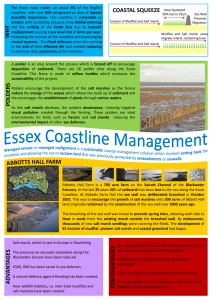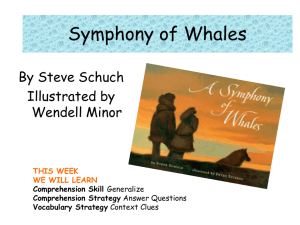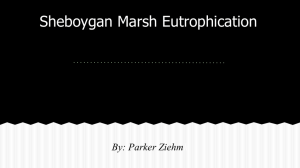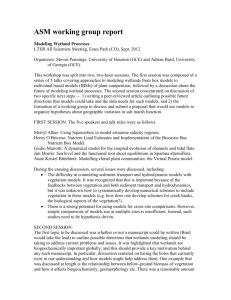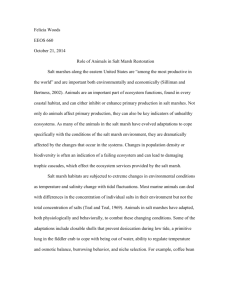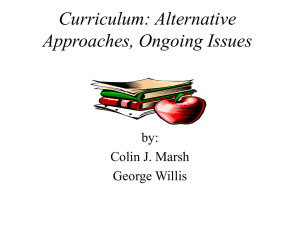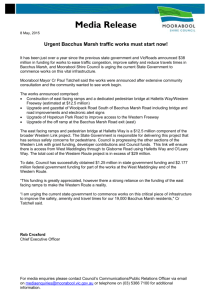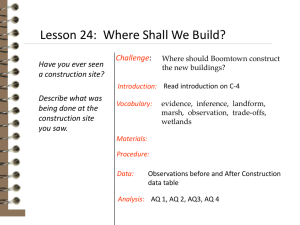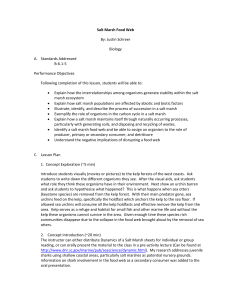Presentation Comments & Q&A
advertisement
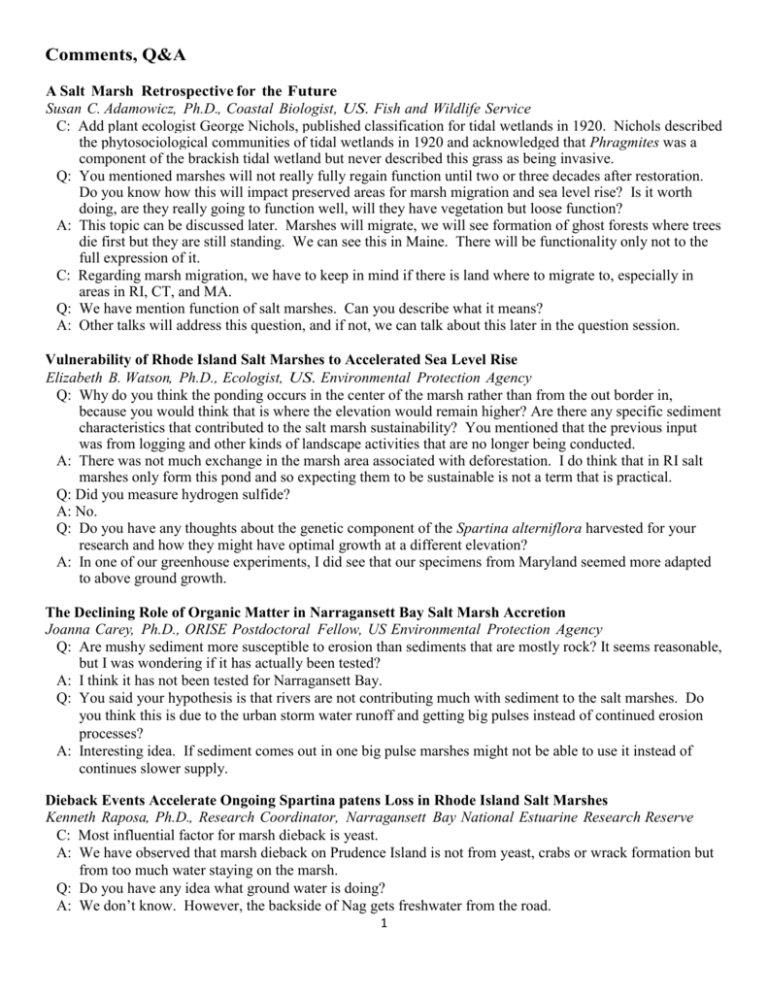
Comments, Q&A A Salt Marsh Retrospective for the Future Susan C. Adamowicz, Ph.D., Coastal Biologist, US. Fish and Wildlife Service C: Add plant ecologist George Nichols, published classification for tidal wetlands in 1920. Nichols described the phytosociological communities of tidal wetlands in 1920 and acknowledged that Phragmites was a component of the brackish tidal wetland but never described this grass as being invasive. Q: You mentioned marshes will not really fully regain function until two or three decades after restoration. Do you know how this will impact preserved areas for marsh migration and sea level rise? Is it worth doing, are they really going to function well, will they have vegetation but loose function? A: This topic can be discussed later. Marshes will migrate, we will see formation of ghost forests where trees die first but they are still standing. We can see this in Maine. There will be functionality only not to the full expression of it. C: Regarding marsh migration, we have to keep in mind if there is land where to migrate to, especially in areas in RI, CT, and MA. Q: We have mention function of salt marshes. Can you describe what it means? A: Other talks will address this question, and if not, we can talk about this later in the question session. Vulnerability of Rhode Island Salt Marshes to Accelerated Sea Level Rise Elizabeth B. Watson, Ph.D., Ecologist, US. Environmental Protection Agency Q: Why do you think the ponding occurs in the center of the marsh rather than from the out border in, because you would think that is where the elevation would remain higher? Are there any specific sediment characteristics that contributed to the salt marsh sustainability? You mentioned that the previous input was from logging and other kinds of landscape activities that are no longer being conducted. A: There was not much exchange in the marsh area associated with deforestation. I do think that in RI salt marshes only form this pond and so expecting them to be sustainable is not a term that is practical. Q: Did you measure hydrogen sulfide? A: No. Q: Do you have any thoughts about the genetic component of the Spartina alterniflora harvested for your research and how they might have optimal growth at a different elevation? A: In one of our greenhouse experiments, I did see that our specimens from Maryland seemed more adapted to above ground growth. The Declining Role of Organic Matter in Narragansett Bay Salt Marsh Accretion Joanna Carey, Ph.D., ORISE Postdoctoral Fellow, US Environmental Protection Agency Q: Are mushy sediment more susceptible to erosion than sediments that are mostly rock? It seems reasonable, but I was wondering if it has actually been tested? A: I think it has not been tested for Narragansett Bay. Q: You said your hypothesis is that rivers are not contributing much with sediment to the salt marshes. Do you think this is due to the urban storm water runoff and getting big pulses instead of continued erosion processes? A: Interesting idea. If sediment comes out in one big pulse marshes might not be able to use it instead of continues slower supply. Dieback Events Accelerate Ongoing Spartina patens Loss in Rhode Island Salt Marshes Kenneth Raposa, Ph.D., Research Coordinator, Narragansett Bay National Estuarine Research Reserve C: Most influential factor for marsh dieback is yeast. A: We have observed that marsh dieback on Prudence Island is not from yeast, crabs or wrack formation but from too much water staying on the marsh. Q: Do you have any idea what ground water is doing? A: We don’t know. However, the backside of Nag gets freshwater from the road. 1 Developing a Salt Marsh Assessment Focused on the Impacts of Rapid Sea Level Rise Marci Cole Ekberg, Ph.D., Coastal Ecologist, Save The Bay Q: Could you clarify the slide about prioritizing-green versus red? You said ‘these are in good shape”, but good shape in terms of what? A: We looked at 40 different marshes and being in good shapes is relative to each other; good shape would be if it still maintains Spartina patens. Q: Did you look at depth of peat versus depth of sediment? A: We did not. Originally we looked at the root biomass. It would be an interesting parameter to add. Q: Are the die-off areas related to their bearing capacity? A: Q: You mentioned that the marshes that are in worst shape are the ones we should focus our restoration efforts. This is something we want to talk about since if we cannot save them all, we might as well focus on the ones that are better shape in the green, instead of the ones in red or in not so good shape. A: Potentially; however, it could be different strategies for each category. C: This might be good discussion for the afternoon session. A GIS Assessment of Salt Marsh Change in Rhode Island from 1981to 2008 Meghan Nightingale, Wild & Scenic Q: When you did the delineation in the field the S patens zones where those dominated by S. patens or did you find transitional areas –a mix of S. patens and S. alterniflora? A: Those zones were dominated by S. patens, no mix at the time. Q: You mentioned there is an average of 71% increase in development around salt marshes. Do nutrients from development have an impact on salt marsh degradation, like from septic systems, for example? Did you grade areas that rely on septic systems versus sewage areas? A: I did not. Q: Did you look at S. alterniflora and S. patens change in coverage? A: I could not delineate changes in vegetation with confidence in the images of 1981, so I didn’t continue with the subsequent years. Perhaps if the images from 1981 were better… Q: How do you identify a marsh since they are kind of continuous? A: That is a great point and I struggled myself with that. However, delineating the vegetation was done to correlate with the sparrow population, and that’s how we established limits. Q: Did you look at other factors like migrations? A: I might have looked at it but that was beyond the scope of my work. C: Regarding vegetation losses, it is not only what you see above but also what is going on below ground. The root morphology of S. patens is quite different and more susceptible to water logging when compared to S. alterniflora. This is something to keep in mind when looking at mechanisms for losses and for future monitoring; for instance, marsh elevation which will make water logging very important. Salt Marshes and Sea Levels in Eastern Long Island Sound R Scott Warren, Ph.D., Tempel Professor of Botany, Emeritus, Connecticut College Q: About the inundation tables, do you think there is a threshold when you start to see vegetation changes, let’s say, in 25 or 50% inundation? A: Inundation might not be the problem. C: A number of species have a sea level rise curve that has to be taken with great deal of caution. The error is so large; it is suggested to look at longer tidal records instead. Q: Was there a difference in marsh elevation between sites or slope? A: There was a big difference in elevation, in terms of slope, they were gentle. 2 Marsh Elevation Monitoring Efforts and Conservation Strategy Development by the Nature Conservancy on Long Island, NY Adam Starke, Coastal and Marine Conservation Coordinator, The Nature Conservancy on Long Island C: I noticed that we hadn’t really touched the ecosystem underneath the salt marsh. Salt marsh plants are not the only organisms living within the salt marsh and I think that looking at that in terms of monitoring and sea level rise is very important; the rib mussels may help with accretion, whereas the fiddler crab can help with erosion. Q: I was wondering about the real estate tax used to purchase parcels for wetland migration, did you get pushed back from the communities that you are taking prime property out of the tax base? A: I am not familiar with that section since that is more policy than science. However, from what I understand, not much. Can Tidal Marsh Birds Persist in the Face of Climate Change? Chris Field, Ph.D. Candidate, University of Connecticut Q: Are seaside sparrows one of those marsh birds that will lay eggs a second time if they fail the first time around. A: They will to a certain point. If they success and have time, they will try again too. If they cannot time the first high tide very well, they will all fail. Q: You talked about how restoration is not necessarily so great for sparrows, how about restoration for some of the seaside sparrow you studied? A: There were no difference between control and Phragmites restored sites. Salt Marsh Adaptation Strategies in Rhode Island in Light of Sea Level Rise Wenley Ferguson, Director of Habitat Restoration, Save The Bay C: When we go to communities and talk about sea level rise affecting marsh migration, I ask our partners not to highlight the sediment deposition technique as something we will start doing on every other project. We need to be cautious with this approach. We are working with Fish and Wildlife Refuge, and they are considering it as a very control technique to try to increase the elevation based upon what we heard today. They are very concerned about maintaining the habitat in the marshes in the refuge property. We are not promoting this technique; because it is filling. We need to ensure that this is not done in a way that can promote anything but a healthier marsh. Sea Level Rise Impacts on Salt Marshes: Implication for Coastal Zone Management in RI Caitlin Chaffee, Policy Analyst, Rl Coastal Resources Management Council Q: Your projection based on migration, and people that had lost a lot of land, can you comment on that? A: I think that the take home is that we need treat model results with a grain of salt and look at what is happening on the ground. We have been doing that with the SLAMM effort. As we continue groundtruthing, we will have more and more information. Q: Sea level rising is happening, how does it translate into horizontal in the salt marsh? Are we seeing that? A: It would be an interesting thing to look at. I think that whether it is part of SLAMM effort or restoration strategies, having more accurate elevation data would help. C: The results from SLAMM show there are challenges with the migration, I feel that region wide in our watershed there are more potential for migration in Taunton and Palmer. We are seen inland edges moving inland. 3
